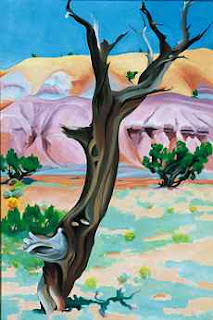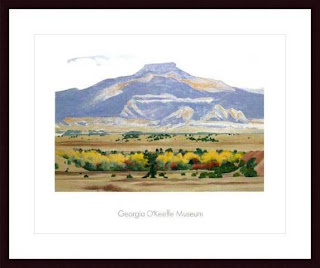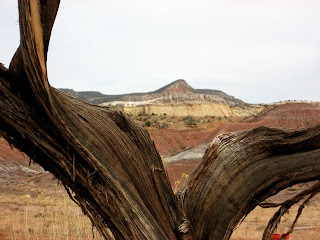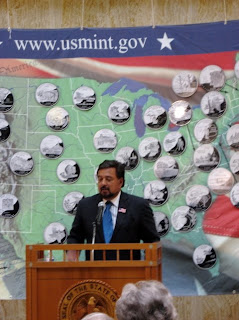 Photo courtesy of the Green Cross International web site
Photo courtesy of the Green Cross International web siteOn Monday night, I had the opportunity to hear Mikhail Gorbachev speak to an enthusiastic crowd of 800 at The Lensic in Santa Fe. When I first heard he was coming to town, I felt I
had to attend--he was just such an important figure of the 20th century for me.
The event was a benefit for the
Santa Fe Institute, and was the first stop on a US lecture tour for the former Soviet president. Ticket prices ranged from $35 for the nosebleed seats, to a $500 opportunity to mingle with Gorbachev at a dinner and reception before the speech. All tickets for the event, with the exception of a handful of $100 seats, were sold.
New Mexico Governor Bill Richardson was on hand to introduce Gorbachev, and to show a brief film on his life and work.
In 1993, Gorbachev founded
Green Cross International, an organization whose mission is to to "help ensure a just, sustainable and secure future for all by fostering a value shift and cultivating a new sense of global interdependence and shared responsibility in humanity's relationship with nature".
Gorbachev stated that in the past few decades, "globalization" has largely benefitted the wealthy, and the gap between rich and poor has widened. Neither Russia nor the U.S. has fulfilled the commitments they made to poor countries, and a new generation of political leaders has "underestimated the need for cooperation". "Global glasnost" or "Planetary glasnost" was a phrase Gorbachev used several times in his speech. He decried the fact that only 1/3 of the world lived in "decent conditions", and stressed the linkage among poverty, environmental damage, and armed conflict.
For example, stresses on food and water supplies, exacerbated by environmental crisis, impact the poor the most, and have led to conflicts and riots which were then addressed by military force.
In Gorbachev's opinion, there are three keys to solve these problems: a change in priorities, global governance, and leadership through partnership. He wondered whether the world could actually turn things around because of vested interests, inertia, and a "deficit of leadership and political will." He feels that the United States has both the biggest capability to make action happen, and the biggest responsibility to do so. But as long as the US. continues its military expansion, the needed work gets neglected.
Gorbachev strongly supports the UN, and other existing world organizations such as the IMF and WTO. He also believes in the importance of regional agreements such as NAFTA and the EU. But he believes that NATO is becoming too powerful, and a UN rival, and that some of the issues NATO is charged with would be better handled by the UN Security Council. In the same vein, he denounced John McCain's proposed
"League of Democracies", although he did not mention McCain by name. Democracies abhor dictatorships, yet such a league would propose that a number of "like-minded" countries would try to dictate to the rest of the world how it should behave.
Gorbachev concluded his speech (after noting that his daughter Irina's polite coughing in the front row signaled that he had been speaking too long!) with a famous quote from an address John F. Kennedy delivered at American University in June 1963:
What kind of peace do I mean? What kind of peace do we seek? Not a Pax Americana enforced on the world by American weapons of war. Not the peace of the grave or the security of the slave. I am talking about genuine peace, the kind of peace that makes life on earth worth living, the kind that enables men and nations to grow and to hope and to build a better life for their children--not merely peace for Americans but peace for all men and women, not merely peace in our time but peace for all time.The crowd in Santa Fe was clearly receptive to the message, giving Gorbachev a standing ovation both before and after he spoke. While the simultaneous translation sometimes made it hard to hear (you had to really focus in on the English and try to tune out the buzz of Russian just below it), the speech was quite moving, and I was really glad to have had the experience. I especially liked the holistic approach of looking at security/terrorism, poverty, and the environmental crisis through a single lens.
 Earlier this month, I took a drive north with a friend up to Abiquiu and beyond. We lunched at the Abiquiu Inn, and then drove to Ghost Ranch, where Georgia O'Keeffe lived and painted in the summer months for nearly 50 years, beginning in 1934. Ghost Ranch has a long and colorful history which is well and thoroughly covered by Lesley Poling-Kempes in her 2005 book Ghost Ranch. It was a dude ranch at the time O'Keeffe began her life there, and is now a Presbyterian retreat and conference center.
Earlier this month, I took a drive north with a friend up to Abiquiu and beyond. We lunched at the Abiquiu Inn, and then drove to Ghost Ranch, where Georgia O'Keeffe lived and painted in the summer months for nearly 50 years, beginning in 1934. Ghost Ranch has a long and colorful history which is well and thoroughly covered by Lesley Poling-Kempes in her 2005 book Ghost Ranch. It was a dude ranch at the time O'Keeffe began her life there, and is now a Presbyterian retreat and conference center. After the exhibit and the publication of the book, the Ghost Ranch was besieged with questions on how to find the locations shown in the paintings and photographs. Many of the vantage points were in areas of the property not open to tourists. But it didn't take long for the Ranch to figure out that there was a great opportunity here, and they started a twice a week ($25 a head) van tour which drives down by O'Keeffe's house on the property and shows visitors her "front yard" and "back yard" views.
After the exhibit and the publication of the book, the Ghost Ranch was besieged with questions on how to find the locations shown in the paintings and photographs. Many of the vantage points were in areas of the property not open to tourists. But it didn't take long for the Ranch to figure out that there was a great opportunity here, and they started a twice a week ($25 a head) van tour which drives down by O'Keeffe's house on the property and shows visitors her "front yard" and "back yard" views.




















